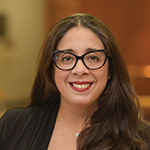
Dr. Blanco
In a commentary in Nature Reviews Rheumatology, Dr. Blanco and her co-author, Shereen N. Mahmoud, MD, noted that most women in rheumatology aren’t on traditional tenure tracks; rather, they tend to be clinician-educators, which puts them at higher risk of leaving academia. What’s more, because promotions often rely on publishing, clinician-educators may be at a disadvantage compared with their peers in other tracks.8
Some of this burden is related to motherhood and the time needed for maternity leave and childcare. “Research isn’t necessarily a 9-to-5 job,” says Rebecca Haberman, MD, a clinical instructor in the Department of Medicine at the NYU Grossman School of Medicine. “When you’re doing research, when that data comes in, that’s when you’re analyzing it. When the grant cycles are, that’s when you’re submitting it. Research doesn’t wait for you.”
Maria Danila, MD, MSc, MSPH, physician-scientist at the University of Alabama at Birmingham, applied for more grants and did more research during the pandemic than before. One reason is that she identified an opportunity and designed an outcomes study—satisfaction and success of using telemedicine, for which she was awarded a research grant from the Rheumatology Research Foundation—that could only be performed during such a unique time. With two kids at home, Dr. Danila coordinated with her husband to manage home duties, oversee virtual school and keep up with an increased workload, but it affected her home life and her children.

Dr. Haberman
“It’s hard for me to hear, ‘Mom, you work all the time,’” she says. “While it’s true at times, when there are grant and project deadlines, that creates an internal conflict, and I think you feel pulled in different directions by your professional and personal life.”
Colleen K. Correll, MD, MPH, who also has two young children and a supportive partner at home, says she went into “survival mode” during the pandemic.
“Like a lot of people, I was just trying to stay afloat and basically was trying to do as much work as I could but also trying to take care of my kids,” says Dr. Correll, who is a pediatric rheumatologist at the University of Minnesota, Minneapolis. “I’m in a much better place now—both of my kids are back in school full time—but looking back at that time, which wasn’t that long ago but in certain ways feels like forever ago, it was insane.”
In addition to the pandemic in 2020, the U.S. is also dealing with a “racial reckoning” that intensified after George Floyd was killed, notes Dr. Blazer. This environment put more pressure on people of color, who have since been asked to tackle the hard work of addressing systemic racism.
Dr. Blazer worked “from morning to night,” she says, to contribute toward the pandemic efforts, promote diversity, equity and inclusion (DEI), and support her family and community during the pandemic. She taught and lectured more, had added responsibilities at home and took care of family members with COVID-19, which affected communities of color disproportionately.9


